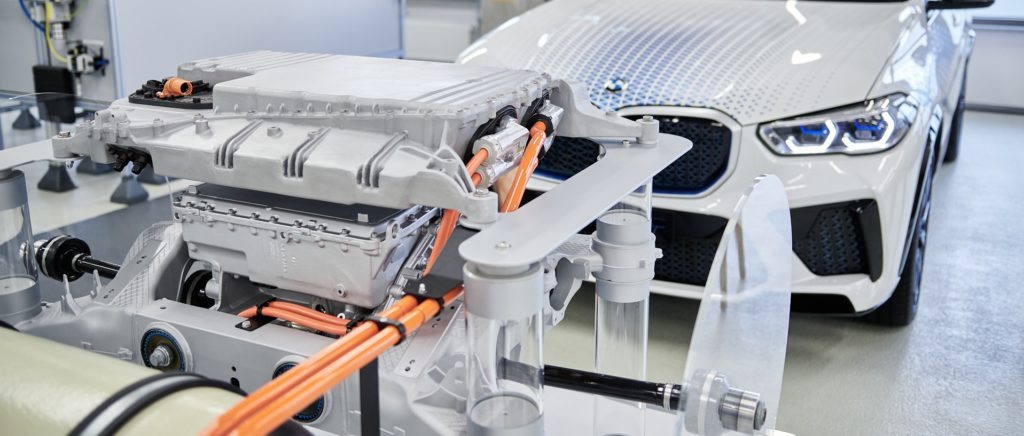Warning: preg_match(): Unknown modifier 'B' in /home/e5xnw5ipsz5s/public_html/wp-content/plugins/powerkit/modules/lazyload/helpers/helper-powerkit-lazyload.php on line 146
Warning: preg_match(): Unknown modifier 'B' in /home/e5xnw5ipsz5s/public_html/wp-content/plugins/powerkit/modules/lazyload/helpers/helper-powerkit-lazyload.php on line 146
Warning: preg_match(): Unknown modifier 'B' in /home/e5xnw5ipsz5s/public_html/wp-content/plugins/powerkit/modules/lazyload/helpers/helper-powerkit-lazyload.php on line 146
Here’s How BMW Says its Hydrogen-Powered Cars Will Work and Why They May or May Not be for You
BMW has begun testing the hydrogen fuel-cell version of its crossover SAV, trying it out on European roads ahead of a small-batch production run next year.
In fact, the BMW i Hydrogen Next has already made its debut at the 2019 Frankfurt Motor Show. The hydrogen SUV combines a Toyota fuel-cell stack with fifth-generation electric-motor tech from BMW’s latest battery-electric cars – and total system output is 374 horsepower. The output is achieved using both the fuel-cell stack, which produces 170 hp, as well as a battery buffer – which kicks in when accelerating or “overtaking”, according to the website.
This is how it works: Hydrogen is stored in two cylindrical tanks, including one that runs down the vehicle’s centerline while the other sits beneath the rear-seat area and is made from carbon fiber-reinforced plastic. A refill takes just three to four minutes, BMW says.
Here’s a little more in-depth point-by-point look at the hydrogen fuel-cell technology courtesy of BMW:

1. In the fuel cell of an FCEV, hydrogen and oxygen generate electrical energy. This energy is directed into the electric motor and/or the battery, as needed. In fuel cell technology, something called “reverse electrolysis” process takes place in which hydrogen reacts with oxygen in the fuel cell.
2. The hydrogen comes from one or more tanks built into the FCEV, while the oxygen comes from the ambient air. The results of this reaction are electrical energy, heat and water, which is emitted through the exhaust as water vapor. Therefore, hydrogen-powered cars are locally emission-free!
3. The electricity generated in the fuel cell of a hydrogen engine can take two routes. It either flows to the electric motor and powers the FCEV directly or it charges a battery, which stores the energy until it’s needed for the engine. This battery, known as a Peak Power Battery, is significantly smaller and therefore lighter than the battery of a fully electric car, as it’s being constantly recharged by the fuel cell.
4. Like other e-cars, hydrogen vehicles can also recover or “recuperate” braking energy. The electric motor converts the car’s kinetic energy back into electrical energy and feeds it into the back-up battery.
So what are the pros and cons of hydrogen-powered cars for drivers?
According to BMW: The pros and cons of a particular propulsion technology can be seen from two main perspectives: that of the user, and that of the environment. “If any technology is to succeed as an alternative to the combustion engine, it must be user-friendly and significantly reduce the emission of pollutants,” according to the German automaker.
Let’s further examine the key benefits and disadvantages for drivers/owners of hydrogen fuel cell cars, according to an interview with Axel Rücker, Program Manager Hydrogen Fuel Cell at the BMW Group.

Advantages of hydrogen-powered cars for consumers:
· Electrical propulsion. The propulsion in hydrogen fuel cell cars is purely electrical. When you drive one, it’s similar to driving a regular electric car. That means there is virtually zero engine noise and a peppy start, due to the fact that these motors provide full torque even at low speeds.
· Quick charging time. Depending on the charging station and battery capacity, fully electric vehicles currently require between 30 minutes and several hours for a full charge. The hydrogen tanks of fuel cell cars, however, are full and ready to go again in less than five minutes. For you, the driver, this brings vehicle availability and flexibility to the level of a regular gasoline-powered car.
· Longer range. At the moment, hydrogen cars have a longer range than fully electric cars. A full hydrogen tank will last around 300 miles. Battery-powered cars can match this with very large batteries – which in turn will lead to an increase in both vehicle weight and charging times. Also, the range of fuel cell vehicles is not dependent on the outside temperature. In other words, it does not deteriorate in cold weather.

Current disadvantages of hydrogen-powered cars for users:
Few options for refueling. A hydrogen engine is refueled at special fuel pumps, which in the future will probably find their way into ordinary service stations. For now, there are still very few refueling stations for hydrogen-powered cars.
“We have a chicken and egg problem with hydrogen fuel cell technology,” explains BMW expert Rücker. “As long as the network of refueling stations for hydrogen-powered cars is so thin, the low demand from customers will not allow for profitable mass production of fuel cell vehicles. And as long as there are hardly any hydrogen cars on the roads, the operators will only hesitantly expand their refueling station network.”
Germany, where BMW is headquartered, leads the way in terms of infrastructure for hydrogen fuel cell cars. In order to promote the expansion of refueling infrastructure there, BMW and other automakers have joined forces with hydrogen producers and filling station operators in the Clean Energy Partnership initiative, which plans to expand the hydrogen fueling station network to 130 stations by 2022.
That would allow the operation of about 60,000 hydrogen cars on Germany’s roads. The next target, with a corresponding increase in fuel cell vehicles, will be 400 stations by 2025. More fueling stations are also needed in neighboring countries to actually make it possible to travel outside Germany via FCEV, according to Rücker.
So with all this said, how much do hydrogen-powered cars cost – and why?
In addition to the sparse fueling station network, there is another reason for the as of yet low demand for hydrogen fuel cell cars: they are relatively expensive. The few models of fuel cell vehicles already available on the market cost around $80,000 for a mid- or upper-mid-range vehicle. That’s almost twice as much as comparable fully electric or hybrid vehicles.
There are a range of reasons why hydrogen fuel cell cars are still expensive. In addition to small volumes, which means that production is still to be industrialized, there’s also the question of the need for the precious metal, platinum, which acts as a catalyst during power generation. The amount of platinum needed for vehicle fuel cells has already been greatly reduced. “The general goal is to bring down the price of hydrogen-powered cars to a similar level to that of other electric cars,” explains Rücker.
Another reason for the high purchase price is that hydrogen fuel cell cars tend to be quite large because the hydrogen tank or tanks take up a lot of space. The drive unit for a purely battery-driven electric vehicle, however, fits into small cars. That’s why classic electric cars can currently be found in every vehicle class.
In addition to the cost of purchase, operating costs also play an important role in the cost-effectiveness and acceptance of a propulsion technology. In hydrogen fuel cell cars, these costs are not least dependent on the price of the fuel. At present, 1 lb (0.45 kg) of hydrogen costs around $14 in the U.S., as compared with $4 in Germany (this is the price the H2 Mobility partners have agreed on). An FCEV can drive about 28 miles (45 km) on 1 lb (0.45 kg) of hydrogen. The cost per mile of running hydrogen cars is therefore currently almost twice as high as that of battery-powered vehicles charged at home. Rücker expects these operating costs to converge: “If the demand for hydrogen increases, the price could drop to around USD 2.50/lb (USD 5.60/kg) by 2030.”
How environmentally friendly and sustainable is hydrogen fuel cell technology?
According to BMW, a car that uses only renewable energy and produces no harmful emissions would be ideal from an environmental point of view. So stay tuned…












